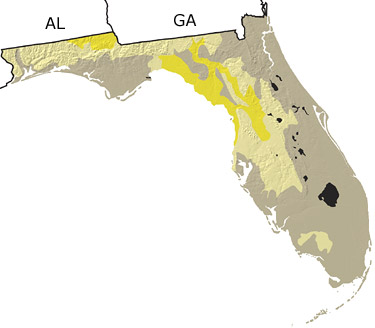Florida, US
|
|
|
Paleontology and geologyThe Precambrian, Paleozoic, and Mesozoic: There are no surface rocks exposed in Florida for the Precambrian through the Mesozoic, although some subsurface rocks do exist and provide us information about Florida’s early history. Prior to the Late Paleozoic, Florida was not attached to our continent. Some subsurface Jurassic rocks indicate that the state was originally part of the ancient southern hemisphere continent of Gondwana. During the Permian, Gondwana collided with what is now North America to form the supercontinent of Pangea. When plate movement tore Pangea apart during the Mesozoic, the crust beneath what is now Florida was left behind as part of the North American continent. The Cenozoic: Cenozoic rocks are well represented in Florida. During the Tertiary, most of the state was covered by a shallow, tropical sea. Gastropods, clams, echinoderms, and other marine animals flourished in great abundance in the warm waters. Sea level fluctuated widely during the Quaternary as glaciers grew and melted in the far northern part of North America. Vast savannas formed during times of lower sea level, and mammoths, mastodons, horses, bison, and other large mammals roamed the state. |
Links to more on Florida paleontology |
|
Collecting and Legalities | Education and Exhibits | Research and Collections | Resources
Collecting and Legalities
Laws on Fossil Collecting (showing 1 of 1 listings)
Florida Fossil Permit: Describes what fossils from state lands in Florida can and can not be collected without a permit from the state. Provides an application form for a Florida fossil permit, which allows holders to legally collect vertebrate fossils on state land.
 Top of List Top of List
Education and Exhibits
Events and Programs (showing 1 of 1 listings)
Pony Express: This Florida Museum of Natural History program promotes the study of fossil horses through research, fieldwork, education, and public involvement.
 Top of List Top of List
Virtual Exhibits (showing 1 of 1 listings)
Fossil Horses in Cyberspace: Take a tour of the Fossil Horse Cybermuseum to learn about palentology and evolution by exploring the rich fossil record of horses. Created by the Florida Museum of Natural History.
 Top of List Top of List
Physical Exhibits (showing 1 of 1 listings)
Hall of Florida Fossils: Evolution of Life and Land: Drawing upon the museum's internationally acclaimed fossil collections, this exhibit encapsulates the last 65 million years of Earth's history.
 Top of List Top of List
Research and Collections
Researchers (showing 1 of 1 listings)
Paleobotany and Palynology at the Florida Museum of Natural History: The Paleobotany and Palynology Collection at the Florida Museum of Natural History is international in scope, including collections from 47 countries. Systematically the greatest strength of the collection is in Cretaceous-Tertiary angiosperms.
 Top of List Top of List
Resources
Databases (showing 3 of 3 listings)
UF Vertebrate Paleontology Databases: On-line, searchable databases of over 200,000 specimens in the collection of the Florida Museum of Natural History, Gainesville.
Neogene Marine Biota of Tropical America: NMITA is an online biotic database containing images and data for taxa used in analyses of Tropical American Biodiversity over the past 25 million years. NMITA is designed for use in research and education in systematics and evolutionary paleontology. Major fossil groups included are bryozoans, corals, molluscs, ostracodes, and fish. Users may browse or search images and information about taxa or click on maps and stratigraphic columns for faunal lists for specific horizons. NMITA also provides several educational activities. 
UF Invertebrate Paleontology Database: On-line, searchable, database of over 2,000,000 specimens in the collection of the Florida Museum of Natural History, University of Florida, Gainesville.
 Top of List Top of List
|
|



